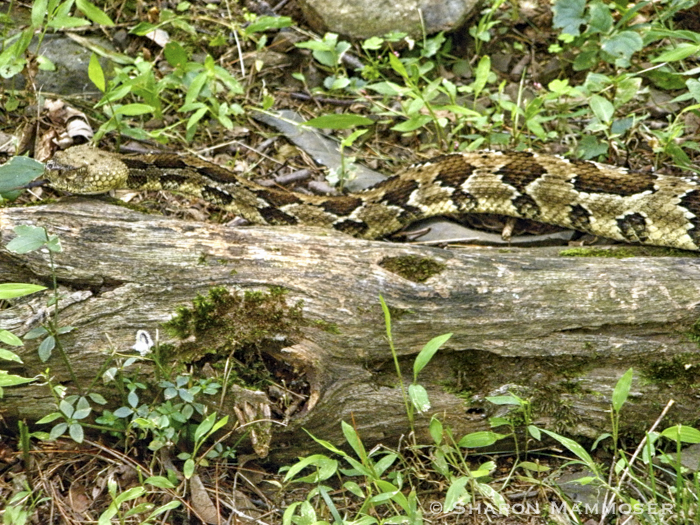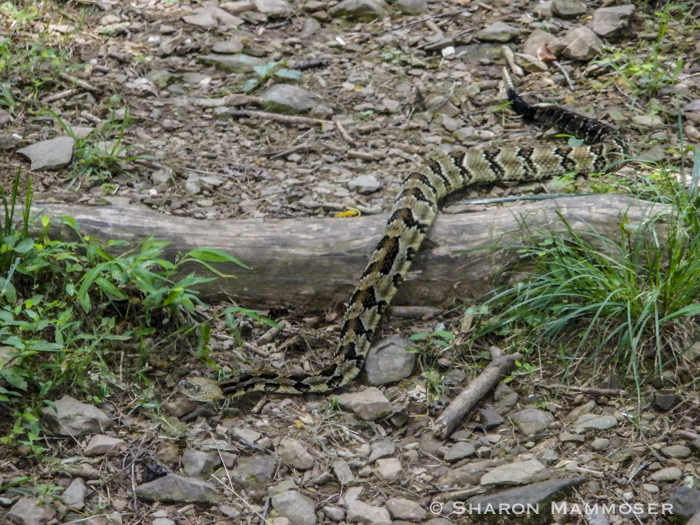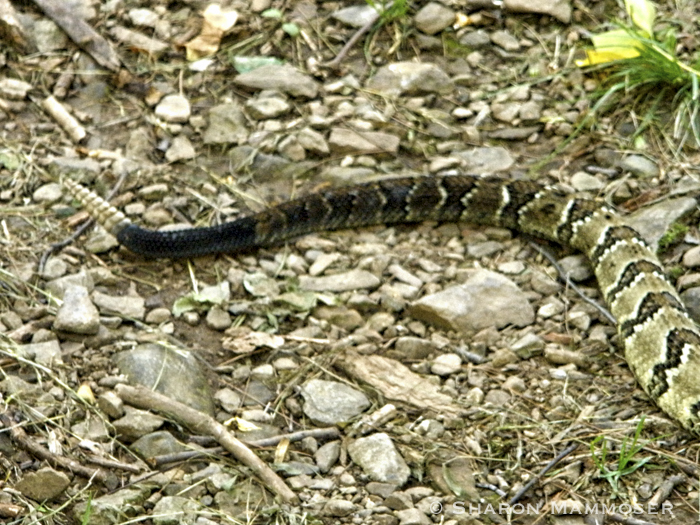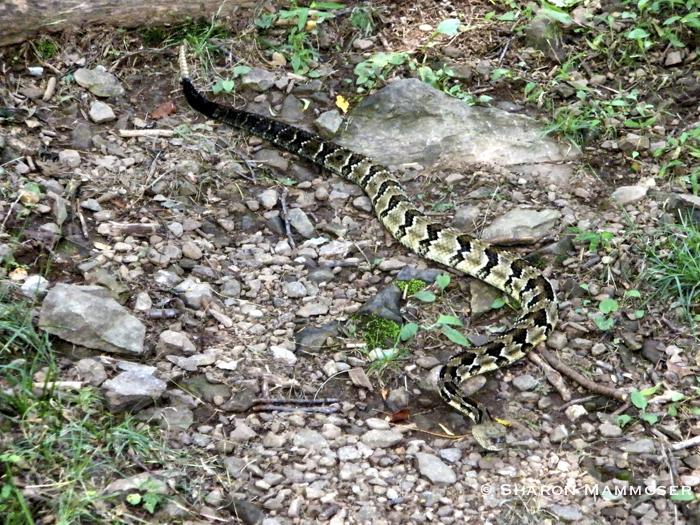 It’s unlikely rattlesnakes will make many Favorite Animal lists, but if you can put your preconceived ideas aside and look at them objectively, maybe you–like me–can come to appreciate them for the amazing–and beautiful creatures they truly are.
It’s unlikely rattlesnakes will make many Favorite Animal lists, but if you can put your preconceived ideas aside and look at them objectively, maybe you–like me–can come to appreciate them for the amazing–and beautiful creatures they truly are.
On my Appalachian Trail thru-hike I got to see many different kinds of snakes, including rattlesnakes. It was my first time seeing them in the wild and from these observations I can conclude that their coloring is highly variable–from yellowish with black or brown cross bands to a dark brown or black with dark cross bands. They are thick-bodied, with black tails, and like all pit vipers, they have a triangular head and two heat-sensing pits behind their eyes.
I thought it would be fun to feature them this week, especially since I just had them as my Weekly Puzzler. Let’s see what we can learn about Timber Rattlesnakes:
 1. Rattlesnakes, as you know, are venomous. But did you know that their venom is costly for them to produce so they don’t waste it? In fact, nearly half of all bites to humans contain little or no venom since rattlesnakes are not viewing us as prey or something they want to eat. These bites are commonly referred to as dry or medically insignificant bites. Of course! This in no way should be a reason for you to approach or try to pick up a rattlesnake! They ARE venomous! If you see one, the best thing you can do is give it plenty of space–just like ANY wild creature you encounter.
1. Rattlesnakes, as you know, are venomous. But did you know that their venom is costly for them to produce so they don’t waste it? In fact, nearly half of all bites to humans contain little or no venom since rattlesnakes are not viewing us as prey or something they want to eat. These bites are commonly referred to as dry or medically insignificant bites. Of course! This in no way should be a reason for you to approach or try to pick up a rattlesnake! They ARE venomous! If you see one, the best thing you can do is give it plenty of space–just like ANY wild creature you encounter.
2. Like all venomous snakes, timber rattlesnakes have vertical pupils. Other, non-venemous snakes have round pupils.
3. Female rattlesnakes give birth to LIVE YOUNG. They carry the eggs around INSIDE of their bodies for 3 to 4 months before giving birth to live snakes, usually 4-14. This is called ovoviviparous.
 4. The rattle of a rattlesnake is made from the same material as your fingernails–keratin. Each time the snake sheds it’s skin–once every 1 or 2 years– a new segment of keratin is added to the end but aging the snake this way is faulty as the rattles easily break off. They vibrate these segments against each other to produce their characteristic rattle. It is uncommon to see a rattlesnake with a rattle more than 10 segments long.
4. The rattle of a rattlesnake is made from the same material as your fingernails–keratin. Each time the snake sheds it’s skin–once every 1 or 2 years– a new segment of keratin is added to the end but aging the snake this way is faulty as the rattles easily break off. They vibrate these segments against each other to produce their characteristic rattle. It is uncommon to see a rattlesnake with a rattle more than 10 segments long.
5. Rattlesnakes don’t always rattle their tails. In my time on the AT, I saw 10 rattlesnakes but only ONE rattled his tail! The rest remained silent, crawling away slowly. Rattlesnakes are not vicious or aggressive! They will usually move out of the way and try to be left alone. Other snakes–including black racers, milk snakes and hognose snakes will shake their tails in leaves to make it sound like a rattle.
6. Rattlesnakes have a long life span–from 16-22 years but don’t reach sexual maturity until they are 5 for males and 7-11 years old for females.
7. Female rattlesnakes only give birth once every 3 or 4 years so in their lifetimes, they might only give birth 2 or 3 times.
8. Rattlesnakes spend the winter underground, in a state much like hibernation, called brumation. They often do this with large numbers of other reptiles, including copperheads and black rat snakes. They might migrate 1.3 to 2.5 miles from their dens each summer.
9. Females lay scent trails to help their offspring locate their winter dens. Baby rattlesnakes have only one segment–often referred to as a button–of keratin. They shed their skins within 10 days of birth, adding a second rattle segment.
10. Timber Rattlesnake populations have declined drastically in the last 20 years. They used to be in 31 states but now are in 27 and some of those are limited to very small areas of the whole. One of the main reasons for this is malicious killing–people killing them just because they don’t like them. Please don’t do this! Rattlesnakes, and other snakes, play an important role in ecosystems, keeping rodent populations in check. Other reasons for their decline are habitat loss, illegal collection, and destruction of their denning sites.
Did I say 10? I have to add these too!
11. Like other snakes, rattlesnakes smell with their tongues–these sensitive organs collect information and translate it to an organ in the roof of their mouths. This is why when you see a snake, it constantly seems to be flicking its forked tongue in and out!
 12. Rattlesnakes change their habits based on the season. In spring and fall they are more active during the day and in summer, more nocturnal.
12. Rattlesnakes change their habits based on the season. In spring and fall they are more active during the day and in summer, more nocturnal.
13 Rattlesnakes are ambush hunters, waiting for prey to come to them. They eat mice, shrews, chipmunks, squirrels, lizards, amphibians, other snakes, and birds.
14. Their fangs are thin and are replaced every 3 or 4 weeks.
Please join me in protecting these interesting creatures! Leave them alone and they will likely return the favor.
Click HERE to read another post about some common snake myths.

